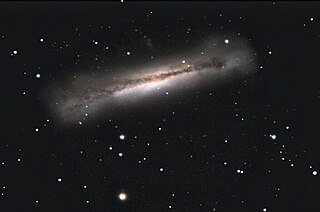
NGC 3628, also known as the Hamburger Galaxy or Sarah's Galaxy, is an unbarred spiral galaxy about 35 million light-years away in the constellation Leo. It was discovered by William Herschel in 1784. It has an approximately 300,000 light-years long tidal tail. Along with M65 and M66, NGC 3628 forms the Leo Triplet, a small group of galaxies. Its most conspicuous feature is the broad and obscuring band of dust located along the outer edge of its spiral arms, effectively transecting the galaxy to the view from Earth.

Messier 77 (M77), also known as NGC 1068 or the Squid Galaxy, is a barred spiral galaxy in the constellation Cetus. It is about 47 million light-years (14 Mpc) away from Earth, and was discovered by Pierre Méchain in 1780, who originally described it as a nebula. Méchain then communicated his discovery to Charles Messier, who subsequently listed the object in his catalog. Both Messier and William Herschel described this galaxy as a star cluster. Today, however, the object is known to be a galaxy. It is one of the brightest Seyfert galaxies visible from Earth and has a D25 isophotal diameter of about 27.70 kiloparsecs (90,000 light-years).

NGC 1512 is a barred spiral galaxy approximately 38 million light-years away from Earth in the constellation Horologium. The galaxy displays a double ring structure, with a (nuclear) ring around the galactic nucleus and an (inner) further out in the main disk. The galaxy hosts an extended UV disc with at least 200 clusters with recent star formation activity. NGC 1512 is a member of the Dorado Group.
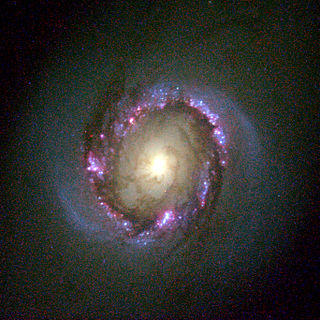
NGC 4314 is a barred spiral galaxy approximately 53 million light-years away in the northern constellation of Coma Berenices. It is positioned around 3° to the north and slightly west of the star Gamma Comae Berenices and is visible in a small telescope. The galaxy was discovered by German-born astronomer William Herschel on March 13, 1785. It was labelled as peculiar by Allan Sandage in 1961 because of the unusual structure in the center of the bar. NGC 4314 is a member of the Coma I group of galaxies.
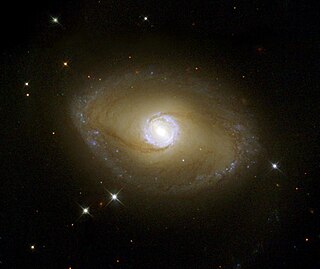
NGC 6782 is a barred spiral galaxy located in the southern constellation of Pavo, at a distance of approximately 173 megalight-years from the Milky Way. It was discovered on July 12, 1834 by English astronomer John Herschel. John L. E. Dreyer described it as, "considerably faint, considerably small, round, a little brighter middle, 9th magnitude star to south". The morphological classification of NGC 6782 is (R1R′2)SB(r)a, indicating a barred spiral galaxy with a multiple ring system and tightly-wound spiral arms. It is seen nearly face-on, being inclined by an angle of 27.2°±0.2° to the line of sight from the Earth.

NGC 1672 is a barred spiral galaxy located in the constellation Dorado. It was discovered by the astronomer James Dunlop on November 5, 1826. It was originally unclear whether it was a member of the Dorado Group, with some sources finding it to be a member and other sources rejecting its membership. However, recent tip of the red-giant branch (TRGB) measurements indicate that NGC 1672 is located at the same distance as other members, suggesting it is indeed a member of the Dorado Group.
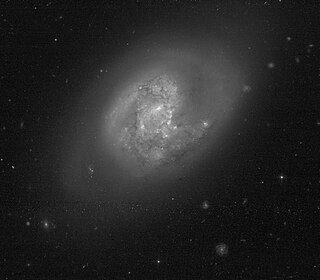
NGC 5665 is a spiral galaxy in the northern constellation of Boötes. It was discovered on January 30, 1784 by German-British astronomer William Herschel. This galaxy is located at a distance of 53.6 ± 7.7 million light-years (16.44 ± 2.37 Mpc), and is receding with a heliocentric radial velocity of 2,237 km/s. It is cataloged in Halton Arp's Atlas of Peculiar Galaxies as object number 49.

NGC 925 is a barred spiral galaxy located about 30 million light-years away in the constellation Triangulum. German-British astronomer William Herschel discovered this galaxy on 13 September 1784.

NGC 1433 is a barred spiral galaxy with a double ring structure located in the constellation of Horologium. It was discovered by James Dunlop on 28 September 1826, and lies a distance of 46 million light-years from Earth.

NGC 4102 is an intermediate barred spiral galaxy located in the northern constellation of Ursa Major. It is visible in a small telescope and has an apparent visual magnitude of 11.2. The galaxy was discovered April 12, 1789 by William Herschel. J. L. E. Dreyer described it as "bright, pretty small, round, brighter middle and bright nucleus". This galaxy is located at a distance of 60 million light years and is receding with a heliocentric radial velocity of 837 km/s. It is a member of the Ursa Major group of galaxies.
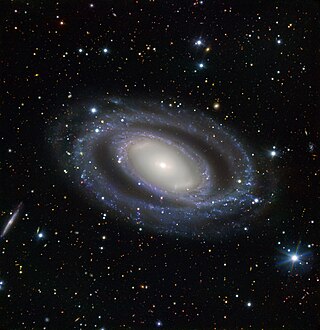
NGC 7098 is a doubled barred spiral galaxy located about 95 million light-years away from Earth in the constellation of Octans. NGC 7098 has an estimated diameter of 152,400 light-years. NGC 7098 was discovered by astronomer John Herschel on September 22, 1835.
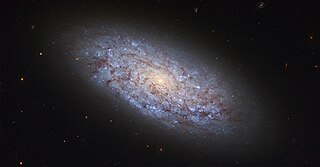
NGC 5949 is a dwarf spiral galaxy located around 44 million light-years away in the constellation Draco. NGC 5949 was discovered in 1801 by William Herschel, and it is 30,000 light-years across. NGC 5949 is not known to have an Active galactic nucleus, and it is not known for much star-formation.

NGC 4999 is a barred spiral galaxy located in the constellation Virgo, first discovered February 24, 1786 by astronomer William Herschel. The galaxy is noted as a particularly bright ultraviolet light source – it is believed that its notable bar structure suppresses star formation, indicating this ultraviolet light may possibly be due to a quasi-stellar object.

NGC 1376 is a spiral galaxy located around 180 million light-years away in the constellation Eridanus. It was discovered in 1785 by William Herschel, and it is 79,000 light-years across. NGC 1376 is not known to have an active galactic nuclei, but it does have lots of star-forming regions.

NGC 1167 is a late type, lenticular, nonbarred galaxy in the Perseus constellation. It was first observed and catalogued in 1784 by the astronomer William Herschel.

NGC 1385 is a barred spiral galaxy in the constellation of Fornax. Its velocity with respect to the cosmic microwave background is 1381 ± 9 km/s, which corresponds to a Hubble distance of 20.37 ± 1.43 Mpc. In addition, 30 non redshift measurements give a distance of 15.999 ± 12.131 Mpc. The galaxy was discovered by German-British astronomer William Herschel on 17 November 1784.

NGC 1162 is a lenticular galaxy located in the constellation Perseus. It was discovered by astronomer William Herschel on October 14, 1784. The galaxy lies approximately 200 million light-years away from Earth and is classified as a type SA0^−^ galaxy, indicating a smooth structure with little to no spiral features.

NGC 1164 is a barred spiral galaxy located in the constellation Eridanus, approximately 60 million light-years from Earth. It was discovered by the astronomer John Herschel in 1834. NGC 1164 is classified as a (R')SAB(rs)b type spiral galaxy, with a prominent central bar structure and well-defined spiral arms.
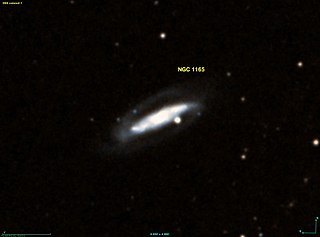
NGC 1165 is a barred spiral galaxy located in the constellation Fornax. It lies approximately 230 million light-years away from Earth and was discovered by astronomer John Herschel in 1835.

NGC 1166 is a barred spiral galaxy located in the constellation Eridanus. It is situated approximately 53 million light-years away from Earth and was discovered by the British astronomer John Herschel on November 17, 1834.




















